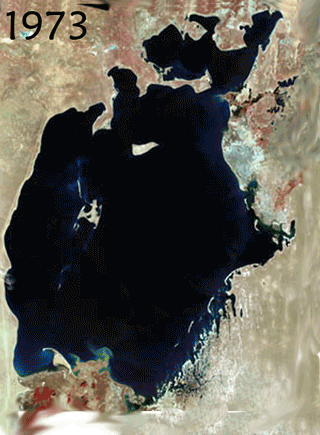Going, Going, Gone
Aral Sea from space, 1985 (credit: NASA)
The Aral Sea was once the 4th largest lake on Earth and a remnant of an ancient inland sea. It is now gone. Ill-conceived bureaucratic engineering schemes during the Soviet Union era, continued into the contemporary Russian Federation, doomed the massive lake. It is now all but gone.
Aral Sea decline, 2000-2018 (credit: NASA/YouTube)
Water from two major Central Asian rivers that once flowed into the Aral. Waters from the Amu Dar'ya and Syr Dar'ya were diverted for vast irrigation schemes to grow cotton in Kazakhstan and Uzbekistan. Without other sources, the lake began to dry up. Where once had been a thriving fishing industry, dry lake beds have now exposed dusty flats filled with toxic pesticides and other agricultural chemicals. The intended agricultural uses were also compromised by the increased salts in the soils as the lake waters evaporated. A photo-animation timeline illustrates the environmental degradation process from 1973 through 2009.

Aral Sea, 1978-2009 with 1960 shoreline (credit: Environmental Defense Fund)
What happened to the Aral Sea and its surrounding environment took less that 50 years. It should be a cautionary tale of how 'best laid plans' can go bad. Similar water diversion developments are still being designed with potentially similar outcomes elsewhere. WHB